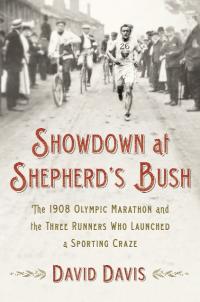Showdown at Shepherd’s Bush: the 1908 Olympic marathon and the three runners who launched a sporting craze
Published in 20th-century / Contemporary History, Issue 4 (July/August 2012), Reviews, Volume 20
Showdown at Shepherd’s Bush: the 1908 Olympic marathon and the three runners who launched a sporting craze
David Davis
(St Martin’s Press, £18.99)
ISBN 9780312641009
Two of the competitors featured in this book had strong Irish connections. The pre-race favourite, Tom Longboat, was a Canadian First Nations athlete who was trained by Pat Flanagan of Kilmallock and spent considerable time training in Ireland before the London games. Johnny Hayes, born and raised in squalid New York City tenement apartments, was the eldest son of Michael Hayes, who left Nenagh, Co. Tipperary, in 1880 and found work in a bakery. (His father, John Hayes, was a baker in Nenagh.) Johnny was born in 1886, the first of six children.Undersized and scrawny, Johnny joined the local St Bartholomew’s athletic club in 1903 and received coaching for the first time. But his life changed abruptly when his parents died within a span of four years. Aged just nineteen, Johnny could only watch as his youngest siblings were placed in an orphanage. He and his brother Willie found work as ‘sandhogs’—underwater diggers—shovelling damp, heavy muck in dreadful conditions to build the New York City subway. The pay was poor and the job dangerous, but Johnny soon boasted a set of bulging muscles.All the while, Hayes ran. He wasn’t the fastest among his peers, but he found that he could absorb the pain, mental and physical, of distance running and then keep fighting. He ran his first marathon in 1906, in Boston, and finished fifth. The following year he was third, swept aside in Canadian Tom Longboat’s record-smashing run. He won the Yonkers marathon in 1907 and took second place at the 1908 Boston marathon. By then Johnny had joined the Irish-American Athletic Club (I-AAC), an athletics powerhouse whose members won numerous Olympic medals in 1904, 1906 and 1908. Worried about contracting rheumatism in the damp tunnels underneath the East River, Johnny Hayes asked the I-AAC to find him a ‘dry job’ and was soon working in the dry-goods section of Bloomingdale’s department store at 59th Street. Whether he showed up at Bloomingdale’s or just drew a salary while training full-time remains a mystery, despite Davis’s exhaustive research. In London, even as newspapers on both sides of the Atlantic were breathlessly predicting a British victory, Hayes feared only one competitor: Tom Longboat. What no one counted on was the heat. On the last full day of Olympic competition, London was a hot, sticky cauldron with hardly a breath of wind. At the start at Windsor, the British contingent jumped into the lead, to the delight of the tens of thousands of spectators lining the course. But their inexperience in the marathon showed as the miles passed and the heat took its toll. After seventeen miles, South Africa’s Charles Hefferon was the front-runner, trailed by Longboat and Italy’s Dorando Pietri. But by now Johnny Hayes, back in the pack for most of the race, was surging.Approaching the twentieth mile, Longboat collapsed, his Olympic dreams in ruins. Nearing Shepherd’s Bush, Pietri passed Hefferon. The Italian entered the stadium with the eyes of 80,000 spectators, including Queen Alexandra, following his every stride. But he was practically unconscious, done in by the conditions, the length of the course and, it was rumoured, dope (in the form of strychnine). He staggered and collapsed five times as he attempted the final circuit; the chief medical officer, Dr Michael Bulger from Dublin, massaged Pietri’s legs and cradled his body on the track. With a last gasp, Pietri was able to rise and cross the finishing line, followed by the gritty Hayes, with Hefferon third. The Italian flag was raised as Pietri was whisked away on a litter. But the American officials (many of them Irish-American) immediately protested. After several hours of deliberation, British officials reluctantly overturned the verdict and Hayes was declared the winner.Hayes was suddenly world-famous. He was fêted by members of parliament, and then left London to tour Ireland. He hobnobbed with Richard Croker, the former boss of Tammany Hall, at his estate outside Dublin and met former Boston mayor John Fitzgerald and his daughter Rose (later mother of President John F. Kennedy). He visited Belfast and the Blarney Stone; in Cork, the Lee Rowing Club honoured him with a dinner and presented him with a gold medal. The highlight was his journey to Nenagh. It seemed as if every local had turned out to greet him when the train from Dublin pulled into the station. Johnny was borne shoulder-high to a waiting carriage amid fireworks and, with the horses unhitched, was pulled through the streets by the crowd to the cottage of the aged, beaming man after whom he was named—his grandfather John Hayes, the baker, who lived on Silver Street. A brass band and a fife and drum corps played outside the residence until late into the night. The drama in Shepherd’s Bush turned Hayes, Pietri and Longboat into international celebrities, and the marathon had now well and truly taken centre stage as the blue riband of athletics. In the autumn of 1908 the trio turned professional and raced marathons against one another in Madison Square Garden and other sold-out arenas across America. During ‘marathon mania’, despite earning tens of thousands of dollars, Johnny Hayes never again defeated Dorando Pietri.David Davis has brought an amazing story to life in the clearest of prose and the most knowledgeable of research, with a real sports fan’s insight. Many will know something of the Pietri collapse already, but few will have realised the full human stories behind all three of the men who made the 1908 marathon possibly the most famous Olympic race of all time. HI
Kevin McCarthy holds a Ph.D in history from University College Cork.
















